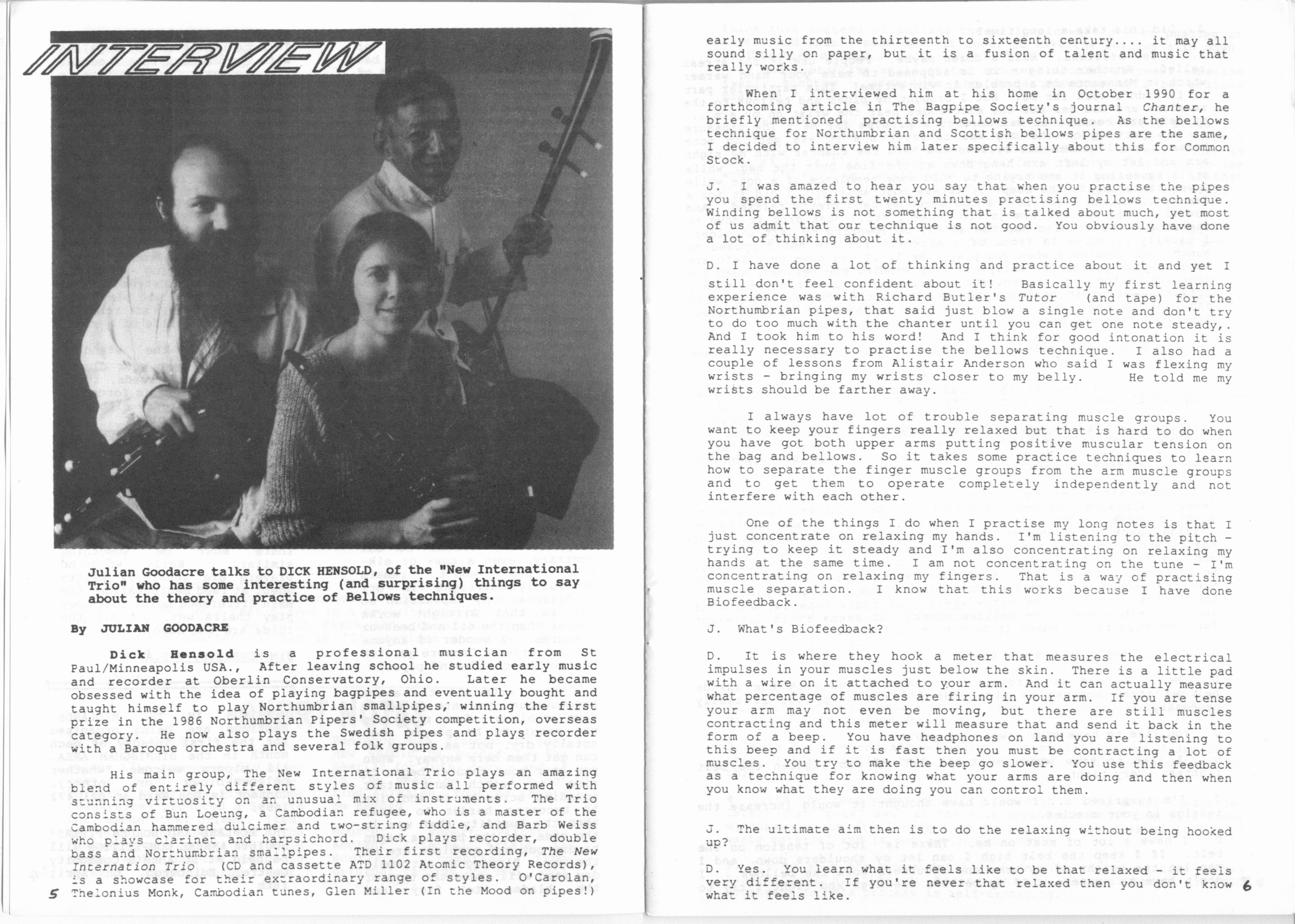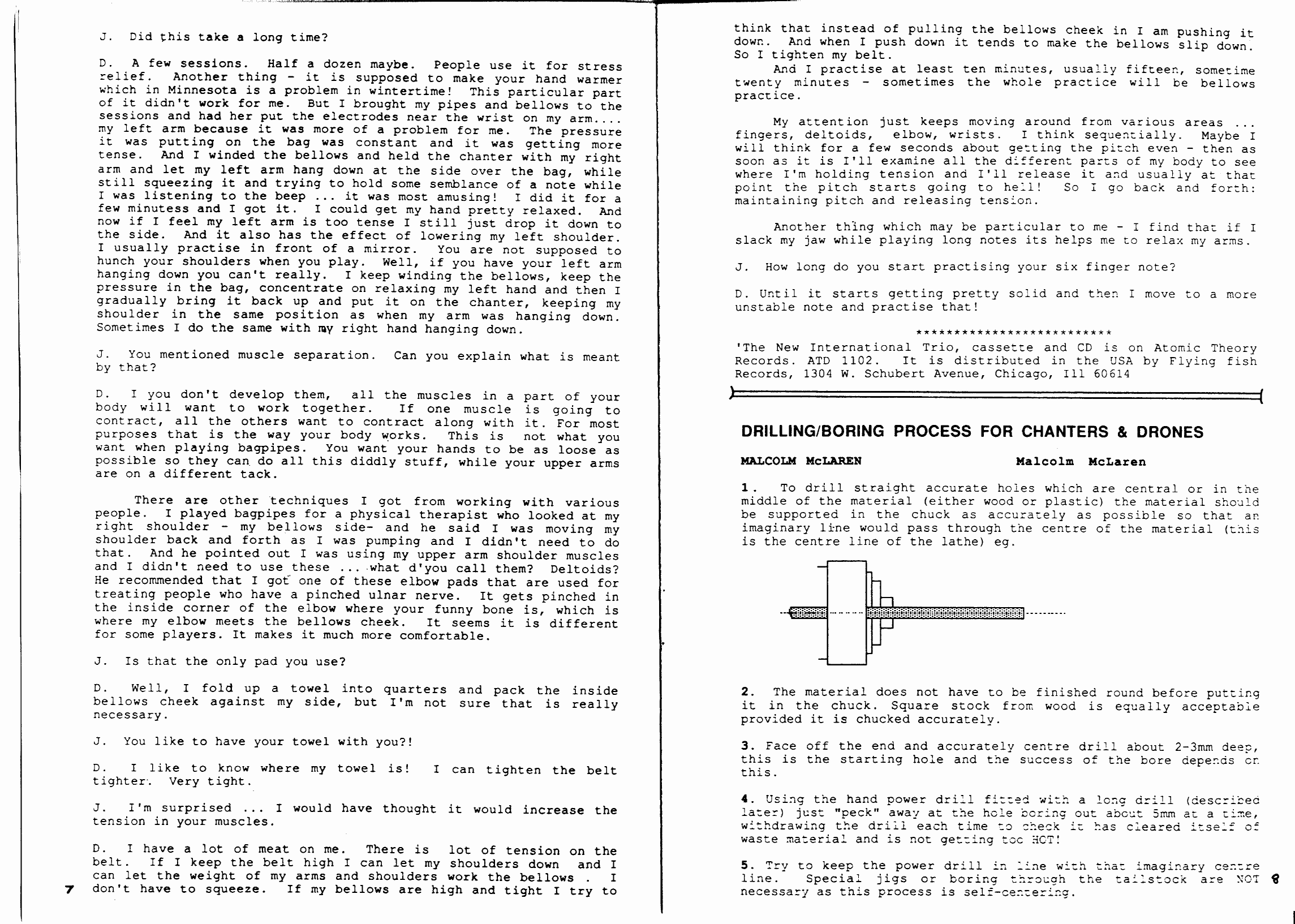Interview with Dick Hensold


Julian Goodacre talks to DICK HENSOLD, of the "New International Trio" who has some interesting (and surprising) things to say about the theory and practice of Bellows techniques.
Dick Hensold is a professional musician from St Paul/Minneapolis USA., After leaving school he studied early music and recorder at Oberlin Conservatory, Ohio. Later he became obsessed with the idea of playing bagpipes and eventually bought and taught himself to play Northumbrian smallpipes, winning the first prize in the 1986 Northumbrian Pipers' Society competition, overseas category. He now also plays the Swedish pipes and plays recorder with a Baroque orchestra and several folk groups.
His main group, The New International Trio plays an amazing blend of entirely different styles of music all performed with stunning virtuosity on an unusual mix of instruments.
The Trio consists of Bun Loeung, a Cambodian refugee, who is a master of the Cambodian hammered dulcimer and two-string fiddie, and Barb Weiss who plays clarinet and harpsichord, Dick plays recorder, double bass and Northumbrian smallpipes. Their first recording, The New Internation Trio (CD and cassette ATD 1102 Atomic Theory Records), is a showcase for their extraordinary range of styles. O'Carolan, Thelonius Monk, Cambodian tunes, Glen Miller (In the Mood on pipes!) early music from the thirteenth to sixteenth century.... it may all sound silly on paper, but it is a fusion of talent and music that really works. When I interviewed him at his home in October 1990 for a forthcoming article in The Bagpipe Society's journal Chanter, he briefly mentioned practising bellows technique. As the bellows technique for Northumbrian and Scottish bellows pipes are the same, I decided to interview him later specifically about this for Common Stock.
J. I was amazed to hear you say that when you practise the pipes you spend the first twenty minutes practising bellows technique. Winding bellows is not something that is talked about much, yet most of us admit that our technique is not good. You obviously have done a lot of thinking about it.
D. I have done a lot of thinking and practice about it and yet I still don't feel confident about it! Basically my first learning experience was with Richard Butler's Tutor (and tape) for the Northumbrian pipes, that said just blow a single note and don't try to do too much with the chanter until you can get one note steady,. And I took him to his word! And I think for good intonation it is really necessary to practise the bellows technique. I also had a couple of lessons from Alistair Anderson who said I was flexing my wrists - bringing my wrists closer to my belly. He told me my wrists should be farther away.
I always have lot of trouble separating muscle groups. You want to keep your fingers really relaxed but that is hard to do when you have got both upper arms putting positive muscular tension on the bag and bellows. So it takes some practice techniques to learn how to separate the finger muscle groups from the arm muscle groups and to get them to operate completely independently and not interfere with each other.
One of the things I do when I practise my long notes is that I just concentrate on relaxing my hands. I'm listening to the pitch -trying to keep it steady and I'm also concentrating on relaxing my hands at the same time. I am not concentrating on the tune - I'm concentrating on relaxing my fingers. That is a way of practising muscle separation. I know that this works because I have done Biofeedback.
J. What's Biofeedback?
D. It is where they hook a meter that measures the electrical impulses in your muscles just below the skin. There is a little pad with a wire on it attached to your arm. And it can actually measure what percentage of muscles are firing in your arm. If you are tense your arm may not even be moving, but there are still muscles contracting and this meter will measure that and send it back in the form of a beep. You have headphones on you are listening to this beep and if it is fast then you must be contracting a lot of muscles. You try to make the beep go slower. You use this feedback as a technique for knowing what your arms are doing and then when you know what they are doing you can control them.
J. The ultimate aim then is to do the relaxing without being hooked up?
D. Yes. You learn what it feels like to be that relaxed - it feels very different. If you're never that relaxed then you don't know what it feels like.
J. Did this take a long time?
D. A few sessions. Half a dozen maybe. People use it for stress relief. Another thing - it is supposed to make your hand warmer which in Minnesota is a problem in wintertime! This particular part of it didn't work for me. But I brought my pipes and bellows to the sessions and had her put the electrodes near the wrist on my arm....my left arm because it was more of a problem for me. The pressure it was putting on the bag was constant and it was getting more tense. And I winded the bellows and held the chanter with my right arm and let my left arm hang down at the side over the bag, while still squeezing it and trying to hold some semblance of a note while I was listening to the beep ... it was most amusing! I did it for a few minutes and I got it. I could get my hand pretty relaxed. And now if I feel my left arm is too tense I still just drop it down to the side. And it also has the effect of lowering my left shoulder. I usually practise in front of a mirror. You are not supposed to hunch your shoulders when you play. Well, if you have your left arm hanging down you can't really. I keep winding the bellows, keep the pressure in the bag, concentrate on relaxing my left hand and then I gradually bring it back up and put it on the chanter, keeping my shoulder in the same position as when my arm was hanging down. Sometimes I do the same with my right hand hanging down.
J. You mentioned muscle separation. Can you explain what is meant by that?
D. If you don't develop them, all the muscles in a part of your body will want to work together. If one muscle is going to contract, all the others want to contract along with it. For most purposes that is the way your body works. This is not what you want when playing bagpipes. You want your hands to be as loose as possible so they can do all this diddly stuff, while your upper arms are on a different tack. There are other techniques I got from working with various people. I played bagpipes for a physical therapist who looked at my right shoulder - my bellows side- and he said I was moving my shoulder back and forth as I was pumping and I didn't need to do that. And he pointed out I was using my upper arm shoulder muscles and I didn't need to use these ... what d'you call them? Deltoids? He recommended that I got one of these elbow pads that are used for treating people who have a pinched ulnar nerve. It gets pinched in the inside corner of the elbow where your funny bone is, which is where my elbow meets the bellows cheek. It seems it is different for some players. It makes it much more comfortable.
J. Is that the only pad you use?
D. Well, I fold up a towel into quarters and pack the inside bellows cheek against my side, but I'm not sure that is really necessary.
J. You like to have your towel with you?!
D. I like to know where my towel is! I can tighten the belt tighter. Very tight.
J. I'm surprised ... I would have thought it would increase the tension in your muscles.
D. I have a lot of meat on me. There is lot of tension on the belt. If I keep the belt high I can let my shoulders down and I can let the weight of my arms and shoulders work the bellows . I don't have to squeeze. If my bellows are high and tight I try to think that instead of pulling the bellows cheek in I am pushing it down. And when I push down it tends to make the bellows slip down. So I tighten my belt. And I practise at least ten minutes, usually fifteen, sometime twenty minutes - sometimes the whole practice will be bellows practice.
My attention just keeps moving around from various areas ...fingers, deltoids, elbow, wrists. I think sequentially. Maybe I will think for a few seconds about getting the pitch even - then as soon as it is I'll examine all the different parts of my body to see where I'm holding tension and I'll release it and usually at that point the pitch starts going to hell! So I go back and forth: maintaining pitch and releasing tension.
Another thing which may be particular to me - I find that if I slack my jaw while playing long notes its helps me to relax my arms.
J. How long do you start practising your six finger note?
D. Until it starts getting pretty solid and then I move to a more unstable note and practise that!
The New International Trio, cassette and CD is on Atomic Theory Records. ATD 1102. It is distributed in the USA by Flying fish Records, 1304 W. Schubert Avenue, Chicago, Ill 66614
